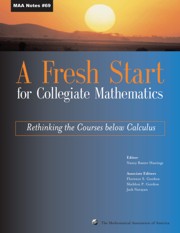Book contents
- Frontmatter
- Preface
- Contents
- Introduction
- 1 The Conference: Rethinking the Preparation for Calculus
- 2 Twenty Questions about Precalculus
- Background
- Theme 1 New Visions for Introductory Collegiate Mathematics
- Theme 2 The Transition from High School to College
- Theme 3 The Needs of Other Disciplines
- Theme 4 Student Learning and Research
- Theme 5 Implementation
- Theme 6 Influencing the Mathematics Community
- Ideas and Projects that Work: Part 1
- Ideas and Projects that Work: Part 2
1 - The Conference: Rethinking the Preparation for Calculus
from Introduction
- Frontmatter
- Preface
- Contents
- Introduction
- 1 The Conference: Rethinking the Preparation for Calculus
- 2 Twenty Questions about Precalculus
- Background
- Theme 1 New Visions for Introductory Collegiate Mathematics
- Theme 2 The Transition from High School to College
- Theme 3 The Needs of Other Disciplines
- Theme 4 Student Learning and Research
- Theme 5 Implementation
- Theme 6 Influencing the Mathematics Community
- Ideas and Projects that Work: Part 1
- Ideas and Projects that Work: Part 2
Summary
Editor's note: The papers presented at this conference form the basis for this volume. This article, which was written shortly after the conference was held in October 2001, gives the rationale for the conference. For a more up-to-date view on some of the issues discussed here, please see the article, “Where Do We Go from Here: Creating a National Initiative to Refocus the Courses below Calculus,” by Sheldon Gordon, later in this volume.
Rationale for the conference
During the last decade, calculus renewal efforts occured at all levels of post-secondary institutions as outgrowths of the Tulane Conference in 1987 and the subsequent national conference on Calculus for A New Century, hosted by the National Academy of Sciences. An MAA special report, Assessing Calculus Reform Efforts [1], estimated that “at least 150,000 students or 32% of all calculus enrollments in the spring of 1994 were in reform courses.” Since 1994, several reform calculus texts have been among the highest selling nationally, and the number of institutions utilizing one or more aspects of reform in their calculus courses continues to rise. The calculus renewal movement continues to have a significant impact on undergraduate mathematics education. Instructors have experimented with alternative teaching methods that included the use of technology, collaborative learning, and out-of-class projects. These methods were integrated into new curricula with an increased emphasis on conceptual understanding. Today, all new editions of calculus texts, even so-called traditional ones, incorporate significant themes and problems developed as part of the calculus renewal movement.
- Type
- Chapter
- Information
- A Fresh Start for Collegiate MathematicsRethinking the Courses below Calculus, pp. 3 - 7Publisher: Mathematical Association of AmericaPrint publication year: 2006

